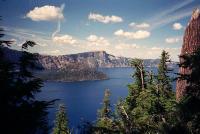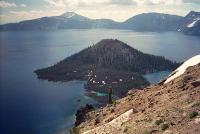I probably should have started on an index sooner; I am not actually sure this was June (it might have been July). It was either late June or early July, though, and there was still quite a bit of snow in places.
Crater Lake is actually the remains of an old volcano (Mount Mazama) that blew its top. The caldera filled with water and is now an incredibly deep freshwater lake -- the deepest in the US, and the seventh deepest in the world, 1958 feet deep. It is also quite high up -- the surface of the lake is nearly 6000 ft above sea level, and the rim is around 7000 ft ASL.
The clarity and depth give the lake a remarkable blue color. The exact shade changes with the light.
The USGS has quite a bit of interesting background information here.
This was actually the first stop on a long trip through parts of the Pacific Northwest. We came up I-5, with a brief detour through Mt Lassen, where I took two not-terribly-interesting pictures out of the car: [1] [2]. From I-5 around Ashland, a number of smaller roads wind their way up to the park.
There is a large island, Wizard Island, in the lake. The boat tour normally allows you to stay on the island (and take a later boat back), but the day I was there, for logisitical reasons, they were not allowing island stays. (They had just done emergency preparedness exercises and were apparently short-handed or something.)

Wizard Island (click for full-size images)

My folks (not a very good picture, but the only one with them in it).
To get to the boat tour, you have to drive around the rim to a spot near (If I recall correctly) the north side of the rim, then hike almost 1000 feet down to the lake level. The hike down is not that bad; it is the one back up that gets you.
The boat tour is well worth it -- both the tour fee, and the slog back up the path in the crater wall.
Here are some thumbnail-free links, for speed: on the lake (very nice blue; you can see some volcanic dikes in the crater wall, too), the island (and others on the boat), the island.
The crater walls have both U- and V-shaped cuts in them. The U-shaped cuts were made by glaciers; V-shaped cuts are made by running water.
In a far corner (well, ok, the lake is nearly round, so it does not really have corners, but perhaps you get the idea) is a second island called Phantom Rock. The name supposedly has to do with the way the rock appears and disappears depending on where you are on the rim. There is no easy way to get onto this rock, and the boat just runs around it. I took a sequence of photos all the way around, I think; here they are: [1] [2][3] [4] [5]. There was something else special about Phantom Rock, but I have forgotten it already.
There are trees growing in the crater walls. What happens when one dies, or topples in a storm? The answer is: it floats around in the lake for a long time. If it has a root ball attached, it can float vertically!
The `Old Man' is a tree that has been floating for some years. The root ball at the bottom, which is probably holding on to some rock, keeps it pointing up like this. Eventually the Old Man will probably sink, but perhaps by then another tree-and-root-ball will have fallen in, and will become the new Old Man. (Note other tree trunks floating horizontally in the background -- these have no root ball to orient them vertically.)
As you climb back up the path, you can use a last few pictures as an excuse to catch your breath.
All contents are copyright © 2001 Chris Torek.